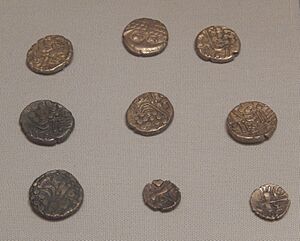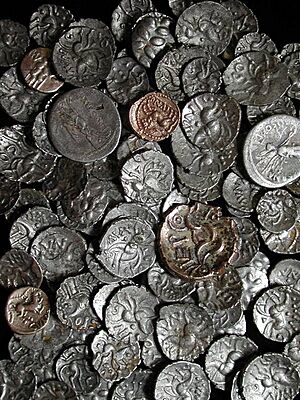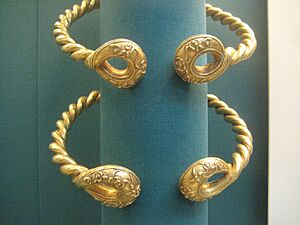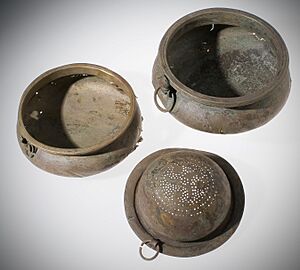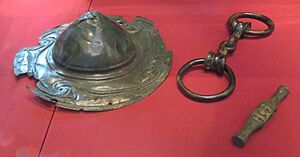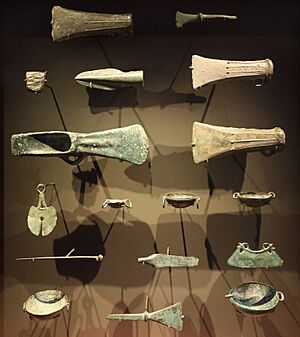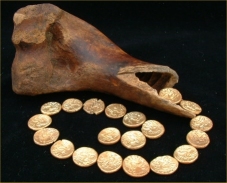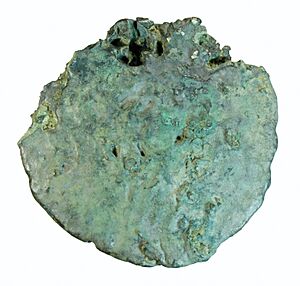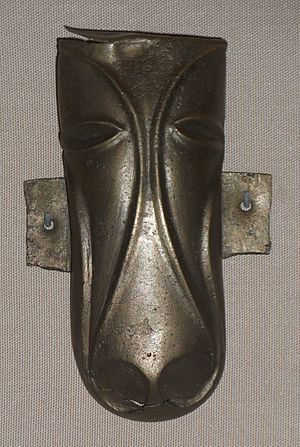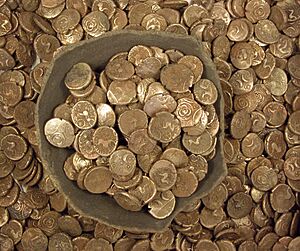List of Iron Age hoards in Great Britain facts for kids
The list of Iron Age hoards in Britain tells us about amazing collections of coins, jewelry, and other valuable items found hidden in Great Britain (that's England, Scotland, and Wales). These treasures come from the British Iron Age, a time roughly from 800 BC to 100 AD.
Some hoards were buried by people who planned to dig them up later, like a secret stash. Others were offerings to gods or spirits, left behind on purpose and not meant to be found again. This list also includes hoards of Celtic coins from when the Romans arrived in Britain. Each hoard helps us learn more about how people lived, what they valued, and what they believed in during the Iron Age.
Discovering Ancient Treasures
Here's a list of some of the most exciting Iron Age hoards found in Britain. Each one offers a unique peek into the past, showing us the types of items people used, traded, and sometimes hid away.
| Hoard | Image | When it was buried | Where it was found | Year found | Where to see it now | What was inside |
|---|---|---|---|---|---|---|
| Alton Hoard | Mid 1st century AD | Alton, Hampshire 51°08′56″N 0°58′37″W / 51.149°N 0.977°W |
1996 | British Museum, London | 50 gold coins (called staters) from leaders like Commios and Tincomarus. Another part had 206 gold staters. Also, a Roman gold ring and bracelet. | |
| Beaminster Hoard | Early 1st century AD | Beaminster, Dorset 50°48′32″N 2°44′24″W / 50.809°N 2.740°W |
2003 | Dorset Museum, Dorchester | 160 silver staters. | |
| Beverley Hoard | Mid 1st century BC | Beverley, East Yorkshire 53°50′42″N 0°25′37″W / 53.845°N 0.427°W |
1999–2007 | Hull Museums Collections British Museum, London |
110 gold staters. | |
| Blythburgh Hoard | Early 1st century AD | Blythburgh, Suffolk 52°19′N 1°36′E / 52.32°N 1.60°E |
2019 | 19 gold staters and quarter staters from Addedomaros, a king of the Trinovantes tribe. | ||
| Cheriton Hoard | 80 to 60 BC | Cheriton, Hampshire 51°03′09″N 1°10′13″W / 51.05245°N 1.170325°W |
1984 | British Museum, London Winchester City Museum |
50 gold staters and quarter staters. | |
| Chute Forest Hoard | 80 to 60 BC | Chute Forest, Wiltshire 51°15′57″N 1°33′23″W / 51.265865°N 1.556348°W |
1927 | British Museum, London | 36 gold staters. | |
| Clacton Hoard | 80 to 60 BC | Clacton-on-Sea, Essex 51°47′31″N 1°08′46″E / 51.79197°N 1.145973°E |
1898 | British Museum, London | 76 gold staters. | |
| Climping Hoard | Mid 1st century BC | Climping, West Sussex 50°48′47″N 0°34′41″W / 50.813°N 0.578°W |
2000 | British Museum, London | 18 gold staters. | |
| Dovedale Hoard | 1st century BC | Reynard's Cave and Kitchen, Dovedale, Derbyshire 53°04′11″N 1°47′05″W / 53.0696°N 1.7848°W |
2014 | Buxton Museum and Art Gallery | 26 gold and silver coins, including Roman coins and coins from the Corieltauvi tribe. | |
| Essendon Hoard | 60 BC to 20 BC | Essendon, Hertfordshire 51°45′46″N 0°09′11″W / 51.762913°N 0.153169°W |
1992 | British Museum, London | 257 gold coins, 7 swords, 4 spearheads, a dagger, a bronze shield piece, and gold torc segments. | |
| Farmborough Hoard | Early 1st century AD | Farmborough, Somerset 51°20′35″N 2°29′02″W / 51.343°N 2.484°W |
1984 | British Museum, London | 61 gold staters. | |
| Field Baulk Hoard | Mid 1st century AD | Field Baulk, March, Cambridgeshire 52°32′20″N 0°05′13″E / 52.539°N 0.087°E |
1982 | British Museum, London | 872 silver coins from the Iceni tribe, found in a round pot. | |
| Great Leighs Hoard | Mid 1st century BC | Great Leighs, Essex 51°49′37″N 0°30′22″E / 51.827°N 0.506°E |
1998–1999 | Chelmsford Museum | 40 gold staters. | |
| Hallaton Treasure | 1st century AD | Hallaton, Leicestershire 52°33′00″N 0°50′00″W / 52.550°N 0.8333°W |
2000 | Harborough Museum | Over 5,000 silver and gold coins, a fancy Roman parade helmet, and jewelry. | |
| Honingham Hoard | Mid 1st century AD | Honingham, Norfolk 52°39′47″N 1°06′29″E / 52.663°N 1.108°E |
1954 | Norwich Castle Museum and Art Gallery | 341 silver coins from the Iceni tribe. | |
| Ipswich Hoard | 1st century BC | Ipswich, Suffolk 52°03′32″N 1°09′22″E / 52.059°N 1.156°E |
1968–1969 | British Museum, London | 6 gold twisted neck rings, called torcs. | |
| Kimbolton Hoard | Mid 1st century BC | Kimbolton, Cambridgeshire 52°18′29″N 0°24′25″W / 52.308°N 0.407°W |
2010 | 67 gold staters and one gold quarter-stater. | ||
| Langstone Hoard | Mid 1st century AD | Ringland, Newport 51°36′36″N 2°53′53″W / 51.610°N 2.898°W |
2007 | 2 bronze bowls and a bronze wine strainer. | ||
| Leekfrith torcs | 4th to mid 3rd century BC | Leekfrith, Staffordshire 53°08′13″N 2°02′42″W / 53.137°N 2.045°W |
2016 | 4 beautiful gold torcs. | ||
| Little Horwood Hoard | 1st century BC | Little Horwood, Aylesbury Vale, Buckinghamshire 51°58′05″N 0°51′00″W / 51.968°N 0.850°W |
2006–2007 | Buckinghamshire County Museum, Aylesbury | 75 staters, thought to be part of the larger Whaddon Chase Hoard. | |
| Llangoed Hoard | Mid 1st century BC | Llangoed, Anglesey 53°17′24″N 4°05′24″W / 53.290°N 4.090°W |
2021–2022 | Oriel Ynys Môn | Fifteen gold staters from the Corieltauvi tribe. | |
| Llyn Cerrig Bach Hoard |
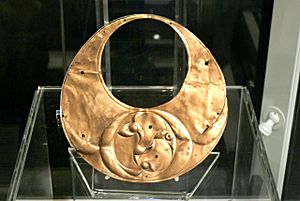
"Crescentic bronze plaque" in the shape of a gold lunula, with triskele-like decoration
|
4th century BC to 1st century AD | Llyn Cerrig Bach, near Valley, Anglesey 53°15′32″N 4°32′24″W / 53.259°N 4.540°W |
1942 | National Museum Cardiff | Over 150 bronze and iron objects, including 7 swords, 6 spearheads, shield pieces, a bronze trumpet, chains, wagon parts, and tools. These were likely votive offerings. |
| Llyn Fawr Hoard | 8th to 7th century BC | Llyn Fawr Lake, Rhigos, Glamorgan 51°43′12″N 3°34′05″W / 51.720°N 3.568°W |
1909–1913 | National Museum Cardiff | A bronze cauldron, chisels, sickles, axes, a sword, a spearhead, a razor, and horse harness equipment. | |
| Lochar Moss Hoard | 50 to 200 AD | Lochar Moss, near Dumfries, Dumfries and Galloway 55°05′09″N 3°34′50″W / 55.0858829°N 3.5806428°W |
1840s | British Museum, London | A brass torc and a bronze bowl. | |
| North Foreland Hoard | Early 1st century BC | North Foreland, Kent 51°22′30″N 1°26′42″E / 51.375°N 1.445°E |
1999 | Powell-Cotton Museum, Birchington-on-Sea | 63 potin coins (made of a bronze alloy with lots of tin). | |
| Peatling Magna Hoard | Mid 1st century BC | Peatling Magna, near Market Harborough, Leicestershire 52°31′41″N 1°07′37″W / 52.528°N 1.127°W |
2012 | Harborough Museum | 10 gold staters, likely from northern France or the Low Countries. | |
| Polden Hill Hoard | 50 AD to 100 AD | Polden Hill, Somerset 51°09′38″N 2°55′26″W / 51.160549°N 2.923972°W |
1800 | British Museum, London | About 90 metal objects, including horse gear, shield pieces, brooches, and bracelets. | |
| Riseholme Hoard | 50 BC to 50 AD | Riseholme, Lincolnshire 53°15′54″N 0°31′48″W / 53.265°N 0.530°W |
2017 | The Collection, Lincoln Museum | 40 gold staters, 231 silver units, and 11 silver half units from the Corieltauvi tribe. | |
| Salisbury Hoard | 3rd century BC | Netherhampton, near Salisbury, Wiltshire 51°04′26″N 1°47′38″W / 51.074°N 1.794°W |
1988 | British Museum, London | Over 600 tiny bronze objects, like miniature shields, tools, daggers, and spearheads. | |
| Scole Hoard | Mid 1st century BC | Scole, Norfolk 52°21′50″N 1°09′22″E / 52.364°N 1.156°E |
1982–1983 | 202 silver coins from the Iceni tribe and 87 Roman coins. | ||
| Sedgeford Hoard | 1st century BC | Sedgeford, Norfolk 52°54′N 0°33′W / 52.90°N 0.55°W |
2003 | King's Lynn Museum | 39 gold staters from Gaul (ancient France/Belgium), hidden inside a cow bone! | |
| Shalfleet Hoard | Late 1st century BC to early 1st century AD | Shalfleet, Isle of Wight 50°42′04″N 1°27′29″W / 50.701°N 1.458°W |
2009 | Sold at Bonhams, 2011. | Four large bowl-shaped silver ingots, six small silver pieces, and one gold British B stater. | |
| Silsden Hoard | Mid 1st century AD | Silsden, West Yorkshire 53°54′50″N 1°56′13″W / 53.914°N 1.937°W |
1998 | Cliffe Castle Museum, Keighley | 27 gold coins and a finger ring. | |
| Snettisham Hoard | Mid 1st century BC | Ken Hill, near Snettisham, Norfolk 52°53′06″N 0°29′20″E / 52.885°N 0.489°E |
1948–1973 | British Museum, London Norwich Castle Museum |
Over 150 gold torc fragments (many forming complete torcs), and other metal and jet objects. | |
| Southend Hoard | 60-50 BC | Southend-on-Sea, Essex 51°32′18″N 0°42′52″E / 51.53832°N 0.714513°E |
1986 | British Museum, London | Pottery pieces and 33 gold staters. | |
| South Norfolk Hoard | Late 1st century BC | South Norfolk | 2012–2013 | Norwich Castle Museum and Art Gallery | 44 'Norfolk Wolf' gold staters (coins with less gold). | |
| South Wight Hoard | Late 1st century BC to early 1st century AD | South Wight, Isle of Wight 50°36′00″N 1°12′00″W / 50.600°N 1.200°W |
2004 | British Museum, London | 18 gold staters, 138 silver staters, other silver and copper coins, silver and copper ingots, and Iron Age pottery pieces. | |
| Stanwick Hoard | 50 BC to 100 AD | Stanwick, North Yorkshire 54°30′24″N 1°43′32″W / 54.506627°N 1.725548°W |
1843 | British Museum, London | About 180 metal objects, including four sets of horse harnesses for chariots and a bronze horse head. | |
| Stirling Hoard | 3rd to 1st century BC | Near Blair Drummond, Stirlingshire 56°10′01″N 4°02′38″W / 56.167°N 4.044°W |
2009 | National Museum of Scotland, Edinburgh | 4 gold torcs. | |
| Stonea Hoard | 20-50 AD | Stonea, Cambridgeshire 52°31′12″N 0°08′35″E / 52.519927°N 0.14303°E |
1983 | British Museum, London | A pottery beaker and over 850 silver coins. | |
| Sunbury Hoard | 2nd century BC | Sunbury-on-Thames, Surrey 51°25′19″N 0°25′08″W / 51.422°N 0.419°W |
1950 | Museum of London, London | 317 tin alloy coins and fragments, plus pieces of a pottery pot. | |
| Syngenta Hoard | Mid 1st century BC | Jealott's Hill, near Bracknell, Berkshire 51°27′22″N 0°44′53″W / 51.456°N 0.748°W |
1998 | Reading Museum | 58 gold coins. | |
| Tal-y-Llyn Hoard | 1st century AD | Near Tal-y-llyn Lake, Cadair Idris, Merionethshire 52°40′19″N 3°53′49″W / 52.672°N 3.897°W |
1963 | National Museum Cardiff | 1 brass plaque, pieces from two brass shields, decorated brass plates (maybe from a ceremonial cart), and part of a Roman lock. | |
| Whaddon Chase Hoard | 1st century BC | Near Whaddon, Aylesbury Vale, Buckinghamshire 52°00′00″N 0°49′41″W / 52.000°N 0.828°W |
1849 & 2006 | British Museum, London Buckinghamshire County Museum, Aylesbury |
Between 450 and 800, and up to 2,000 gold staters. (See also Little Horwood Hoard). | |
| Whitchurch Hoard | 1st century BC | Whitchurch, Hampshire 51°13′44″N 1°20′06″W / 51.229°N 1.335°W |
1987 | Hampshire Museums Service | 34 gold staters from Gaul and 108 British B gold staters. | |
| Wickham Market Hoard | Late 1st century BC to early 1st century AD | Wickham Market, Suffolk 52°09′00″N 1°22′01″E / 52.150°N 1.367°E |
2008 | Ipswich Museum | 840 gold staters. | |
| Winchester Hoard | 1st century BC | Near Winchester, Hampshire 51°03′47″N 1°18′29″W / 51.063°N 1.308°W |
2000 | British Museum, London | 4 gold brooches, 1 gold chain, 1 complete gold bracelet, 2 half bracelets, and 2 gold torcs. | |
| Walkington Hoard | 1st century BC | Walkington, East Yorkshire 53°49′14″N 0°29′17″W / 53.820636°N 0.487977°W |
2005 | Yorkshire Museum, York | A collection of gold staters from the Corieltauvi tribe. Found in different groups but considered one hoard. |
More Hoards to Explore




